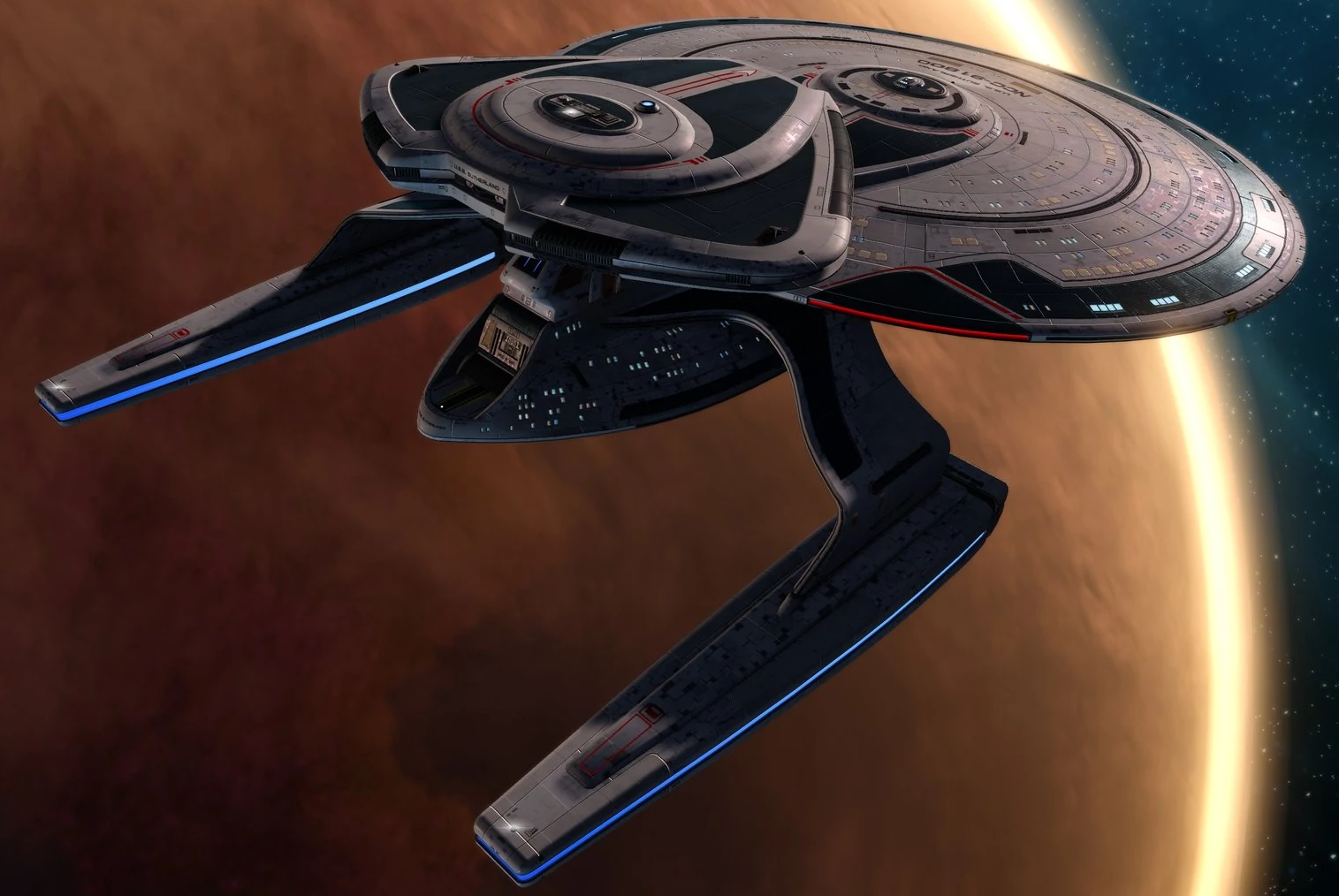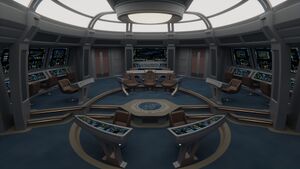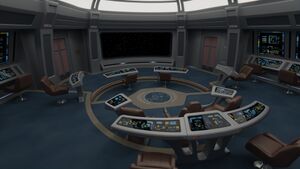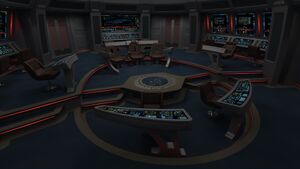Difference between revisions of "USS Hypatia"
(Created page with "{{Starship | name = Hypatia | prefix = USS | image = Image:Sutherland class aftb.png | registry = NCC-91825 | class = Sutherland | type = Research Cruiser | affiliation = Starfleet | status = Active | commission = 2401 | decommission = | destroyed = | unit = | taskforce = Task Force 17 | taskgroup = Task Group 9 | squadron = Lakota Squadron | mothership = | homeport = Deep Space 17 | role = Research Cruiser | co = | xo = | dedication = }}") |
m |
||
| Line 18: | Line 18: | ||
| homeport = Deep Space 17 | | homeport = Deep Space 17 | ||
| role = Research Cruiser | | role = Research Cruiser | ||
| co = | | co = [[bfms_char:68737|Captain Giarvar Kauhn]] | ||
| xo = | | xo = | ||
| dedication = | | dedication = | ||
}} | }} | ||
{{quote|Reserve your right to think, for even to think wrongly is better than not to think at all.|'''Hypatia - ''Ship's Dedication Quote'''''}} | |||
'''USS ''Hypatia''''' is a [[Sutherland Class|''Sutherland''-class research cruiser]] serving in the Fourth Fleet's Task Force 17. | |||
Named after one of Earth's most famous philosophers and astronomers from Alexandria, Egypt, ''Hypatia'' is a vessel of great size and significance. On the surface, she is equipped with all of the necessary equipment and personnel to carry out an array of scientific and exploratory endeavours, but beneath the surface hides something curious. Adjustments made to the vessel following the appointment of her commanding officer have equipped her with systems that allow her to fulfil a dangerous objective; to gather intelligence on Klingon movements near the Romulan Republic and perform reconnaissance patrols as required by Starfleet and their Romulan allies. | |||
As the first of her name to ever grace Starfleet, it is up to Captain and crew alike to forge a name commensurate with the legacy of such an influential thinker and mathematician. | |||
==Mission Objectives== | |||
Once her shakedown is complete and the rest of her senior staff finalised, ''Hypatia'' will embark on missions with a primary focus on scientific exploration. She will, however, gather intelligence and reconnaissance data where required as part of her secondary mission profile. Missions she will conduct include: | |||
* Utilising the vessel's advanced sensors and long-range capabilities to identify and investigate unexplored sectors of space, cataloguing new phenomena, stellar bodies, and potential resources. | |||
* Conducting a wide range of interdisciplinary scientific studies, including astrophysics, exobiology, planetary geology, and stellar cartography, to deepen our understanding of the universe and its inhabitants. | |||
* Conducting in-depth surveys of planets, moons, and celestial bodies to assess their geology, climate, atmosphere, and potential for colonisation or resource extraction. Study indigenous life forms and ecosystems to support conservation efforts and cultural understanding. | |||
* Facilitating diplomatic missions and cultural exchanges with newly encountered civilisations, fostering peaceful relations and mutual understanding through scientific collaboration and shared knowledge. | |||
* Providing assistance in disaster relief efforts, such as planetary natural disasters, medical emergencies, or humanitarian crises, utilising the vessel's medical facilities, transporters, and supply capabilities to support affected populations. | |||
* Investigating ancient ruins, artefacts, and archaeological sites to uncover clues about lost civilisations, cultural heritage, and the history of the galaxy, preserving valuable knowledge and artefacts for future generations. | |||
* Studying and analysing anomalies such as wormholes, subspace rifts, temporal disturbances, and gravitational anomalies to understand their nature, effects on space-time, and potential applications for travel or communication. | |||
* Monitoring the health of ecosystems, celestial phenomena, and cosmic phenomena to assess the impact of stellar events, spacefaring activities, and climate change, contributing to efforts to preserve the natural balance of the cosmos. | |||
*. Collaborating with other Starfleet vessels, scientific institutions, and allied organisations such as the Federation Science Council, Vulcan Science Academy, and Daystrom Institute to share knowledge, resources, and expertise in pursuit of common scientific goals. | |||
==Technical Configuration== | |||
''Main Article: [[Sutherland Class|Sutherland-class Research Cruiser]]'' | |||
Whilst it is clear that ''Hypatia'' will utilise many of her standard equipment and technologies to complete her primary objectives, she was given an impromptu refit upon the arrival of her commanding officer, Captain Kauhn. Having been assigned a secondary objective as an intelligence and reconnaissance platform in the dangerous border regions of the Beta Quadrant, Captain Kauhn authorised yard engineers at [[Avalon Fleet Yards]] to replace the standard sensor pod with the [[Mission Pods|tactical mission pod]], improving her armaments and defensive array whilst still maintaining much of the sensor and communications capabilities she had previously. | |||
===Key Location Data=== | |||
*''Main Article: [[User:Kai1701E/Hypatia/Deck_Listing|''Hypatia'' deck listing]] | |||
*''Main Article: [[User:Kai1701E/Hypatia/Tour|Tour of the ''Hypatia'' ]] | |||
With some 45 decks to her name, ''Hypatia'' is one of the largest vessels in Starfleet, even eclipsing the mighty [[Odyssey Class|Odyssey-class heavy explorer]] by five decks. Much of the ships internal volume is shared between the science, medical and engineering divisions. | |||
==Bridge, Deck 1== | |||
==Bridge== | |||
[[File:Proxima1.jpg|right|thumb|Main Bridge; command center for the USS ''Hypatia'']] | |||
Consisting of an amalgamation of successful features from both the [[Nebula Class|Nebula]] and [[Sovereign Class|Sovereign]] lineages, ''Hypatia'' has one of the more unique bridge modules in the fleet. Importantly, it makes the most of a variety of technological advancements, such as holoprojectors, holographic communications, in-built weapons lockers and three-dimensional computer displays wherever possible. | |||
A unique design feature of the ''Hypatia'' bridge module is the desire to have as many stations as possible facing a single focal point at the heart of the command center. This focal point is the United Federation of Planets emblem proudly displayed on the carpeted deck plating, but this is not for purely decorative reasons. The logo actually serves as a holo-communications platform at the center of the bridge, capable of displaying holoprojections of people lightyears away. Surrounding the holo-platform is the standard tri-seat command pit, with seats for the Captain, Executive Officer (starboard) and a third seat (port), reserved for the use of the ship's Counsellor, or any official or dignitary the Captain sees fit to permit on the bridge. Each seat has independent computer controls allowing access to a wide variety of ship systems. | |||
[[File:Proxima2.jpg|left|thumb|Forward view, including holocommunications platform]] | |||
Directly port and starboard of the command chairs are the inward-facing duty stations for tactical operations (port) and science (starboard). On the perimeter of the bridge there are countless other additional stations designed to support mission operations. Behind the main science station on the starboard bulkhead, additional science and medical consoles are available, as well as access to life support. Adjacent to them on the starboard bulkhead, strategic operations, intelligence and security deployment stations are the focus. Directly behind the command chairs is a large console entirely configurable for the needs of any department, but with dedicated access to engineering functions if required, allowing the Chief Engineer (or any assigned officer) unparalleled access to engineering systems outside of the engineering bay itself. On the aft bulkhead, the obligatory Master Systems Display (MSD) is present, but this is a fully customisable display, capable of hundreds of functions, including operating as a reduced viewscreen for mission operations. | |||
Directly ahead of the command pit, at the bottom of the ramp and between the commanding officer and the holographic viewscreen, two curved consoles serve as duty stations for Operations (port) and Flight Operations (starboard). | |||
[[File:Proxima3.jpg|right|thumb|Main bridge under red alert conditions]] | |||
Around the command center, four doors provide access to and from the bridge. On the forward port bulkhead, access is available to the commanding officer's ready room, and adjacent to it, the observation lounge and strategic operations suite. Aft of the bridge, both doors provide access to turbo lifts which enable the crew to access the command center from the rest of the bridge. Either may be overridden for priority access to key locations around the ship. | |||
Most notably, and a further move away from more recent trends, the bridge module is very well-lit, with the colours and tones in the room complimenting each other nicely and creating a warm aesthetic that is pleasing on the eye. During red alert, however, the bridge lights are dimmed and largely replaced by dozens of strip lights (visible along the floor and walls) that flash five times at the initial call for red alert, and then remain stationary until the alert is cancelled. | |||
==Auxiliary Craft== | |||
As ''Hypatia'' is named after one of Earth's most pivotal free thinkers and philosophers, the naming conventions for her auxiliary craft relate to famous humans from the same, or similar, period in history. | |||
===Shuttlebay 1 - Main Shuttlebay=== | |||
Shuttlebay 1, or the Upper Shuttlebay, has been modified to house all of the auxiliary craft that make up ''Centaurus Flight''. These auxiliary craft are made up of some of the most advanced small vessel designs ever to serve Starfleet. | |||
====Type 14 Shuttles]==== | |||
''Archimedes'', ''Euclid'', ''Hippocrates'', ''Pythagoras'', ''Socrates'', ''Zeno'' | |||
====Type 12 Shuttles==== | |||
''Cicero'', ''Democritus'', ''Empedocles'', ''Heraclitus'', ''Lucretius'', ''Ptolemy'' | |||
===Shuttlebay 2 - Runabout Landing Bay=== | |||
Shuttlebay 2 is the smallest of the auxiliary craft facilities on ''Hypatia'' and is the permanent home of two Arrow-class and two Argo-class runabouts. | |||
====Argo-class Runabouts==== | |||
''Ammonius'', ''Plato'' | |||
====Arrow-class Runabouts==== | |||
''Aristotle'', ''Theon'' | |||
Revision as of 21:25, 2 May 2024

| |
| USS Hypatia | |
| General Information | |
| Registry | NCC-91825 |
| Class & Type | Sutherland-class Research Cruiser |
| Affiliation | Starfleet |
| Status | Active |
| Commissioned | 2401 |
| Assignment | |
| Task Force | Task Force 17 |
| Task Group | Task Group 9 |
| Squadron | Lakota Squadron |
| Home Port | Deep Space 17 |
| Role | Research Cruiser |
| Key Personnel | |
| Commanding Officer | Captain Giarvar Kauhn |
| Template:Starship | |
- "Reserve your right to think, for even to think wrongly is better than not to think at all."
- —Hypatia - Ship's Dedication Quote
USS Hypatia is a Sutherland-class research cruiser serving in the Fourth Fleet's Task Force 17.
Named after one of Earth's most famous philosophers and astronomers from Alexandria, Egypt, Hypatia is a vessel of great size and significance. On the surface, she is equipped with all of the necessary equipment and personnel to carry out an array of scientific and exploratory endeavours, but beneath the surface hides something curious. Adjustments made to the vessel following the appointment of her commanding officer have equipped her with systems that allow her to fulfil a dangerous objective; to gather intelligence on Klingon movements near the Romulan Republic and perform reconnaissance patrols as required by Starfleet and their Romulan allies.
As the first of her name to ever grace Starfleet, it is up to Captain and crew alike to forge a name commensurate with the legacy of such an influential thinker and mathematician.
Mission Objectives
Once her shakedown is complete and the rest of her senior staff finalised, Hypatia will embark on missions with a primary focus on scientific exploration. She will, however, gather intelligence and reconnaissance data where required as part of her secondary mission profile. Missions she will conduct include:
- Utilising the vessel's advanced sensors and long-range capabilities to identify and investigate unexplored sectors of space, cataloguing new phenomena, stellar bodies, and potential resources.
- Conducting a wide range of interdisciplinary scientific studies, including astrophysics, exobiology, planetary geology, and stellar cartography, to deepen our understanding of the universe and its inhabitants.
- Conducting in-depth surveys of planets, moons, and celestial bodies to assess their geology, climate, atmosphere, and potential for colonisation or resource extraction. Study indigenous life forms and ecosystems to support conservation efforts and cultural understanding.
- Facilitating diplomatic missions and cultural exchanges with newly encountered civilisations, fostering peaceful relations and mutual understanding through scientific collaboration and shared knowledge.
- Providing assistance in disaster relief efforts, such as planetary natural disasters, medical emergencies, or humanitarian crises, utilising the vessel's medical facilities, transporters, and supply capabilities to support affected populations.
- Investigating ancient ruins, artefacts, and archaeological sites to uncover clues about lost civilisations, cultural heritage, and the history of the galaxy, preserving valuable knowledge and artefacts for future generations.
- Studying and analysing anomalies such as wormholes, subspace rifts, temporal disturbances, and gravitational anomalies to understand their nature, effects on space-time, and potential applications for travel or communication.
- Monitoring the health of ecosystems, celestial phenomena, and cosmic phenomena to assess the impact of stellar events, spacefaring activities, and climate change, contributing to efforts to preserve the natural balance of the cosmos.
- . Collaborating with other Starfleet vessels, scientific institutions, and allied organisations such as the Federation Science Council, Vulcan Science Academy, and Daystrom Institute to share knowledge, resources, and expertise in pursuit of common scientific goals.
Technical Configuration
Main Article: Sutherland-class Research Cruiser
Whilst it is clear that Hypatia will utilise many of her standard equipment and technologies to complete her primary objectives, she was given an impromptu refit upon the arrival of her commanding officer, Captain Kauhn. Having been assigned a secondary objective as an intelligence and reconnaissance platform in the dangerous border regions of the Beta Quadrant, Captain Kauhn authorised yard engineers at Avalon Fleet Yards to replace the standard sensor pod with the tactical mission pod, improving her armaments and defensive array whilst still maintaining much of the sensor and communications capabilities she had previously.
Key Location Data
- Main Article: Hypatia deck listing
- Main Article: Tour of the Hypatia
With some 45 decks to her name, Hypatia is one of the largest vessels in Starfleet, even eclipsing the mighty Odyssey-class heavy explorer by five decks. Much of the ships internal volume is shared between the science, medical and engineering divisions.
Bridge, Deck 1
Bridge
Consisting of an amalgamation of successful features from both the Nebula and Sovereign lineages, Hypatia has one of the more unique bridge modules in the fleet. Importantly, it makes the most of a variety of technological advancements, such as holoprojectors, holographic communications, in-built weapons lockers and three-dimensional computer displays wherever possible.
A unique design feature of the Hypatia bridge module is the desire to have as many stations as possible facing a single focal point at the heart of the command center. This focal point is the United Federation of Planets emblem proudly displayed on the carpeted deck plating, but this is not for purely decorative reasons. The logo actually serves as a holo-communications platform at the center of the bridge, capable of displaying holoprojections of people lightyears away. Surrounding the holo-platform is the standard tri-seat command pit, with seats for the Captain, Executive Officer (starboard) and a third seat (port), reserved for the use of the ship's Counsellor, or any official or dignitary the Captain sees fit to permit on the bridge. Each seat has independent computer controls allowing access to a wide variety of ship systems.
Directly port and starboard of the command chairs are the inward-facing duty stations for tactical operations (port) and science (starboard). On the perimeter of the bridge there are countless other additional stations designed to support mission operations. Behind the main science station on the starboard bulkhead, additional science and medical consoles are available, as well as access to life support. Adjacent to them on the starboard bulkhead, strategic operations, intelligence and security deployment stations are the focus. Directly behind the command chairs is a large console entirely configurable for the needs of any department, but with dedicated access to engineering functions if required, allowing the Chief Engineer (or any assigned officer) unparalleled access to engineering systems outside of the engineering bay itself. On the aft bulkhead, the obligatory Master Systems Display (MSD) is present, but this is a fully customisable display, capable of hundreds of functions, including operating as a reduced viewscreen for mission operations.
Directly ahead of the command pit, at the bottom of the ramp and between the commanding officer and the holographic viewscreen, two curved consoles serve as duty stations for Operations (port) and Flight Operations (starboard).
Around the command center, four doors provide access to and from the bridge. On the forward port bulkhead, access is available to the commanding officer's ready room, and adjacent to it, the observation lounge and strategic operations suite. Aft of the bridge, both doors provide access to turbo lifts which enable the crew to access the command center from the rest of the bridge. Either may be overridden for priority access to key locations around the ship.
Most notably, and a further move away from more recent trends, the bridge module is very well-lit, with the colours and tones in the room complimenting each other nicely and creating a warm aesthetic that is pleasing on the eye. During red alert, however, the bridge lights are dimmed and largely replaced by dozens of strip lights (visible along the floor and walls) that flash five times at the initial call for red alert, and then remain stationary until the alert is cancelled.
Auxiliary Craft
As Hypatia is named after one of Earth's most pivotal free thinkers and philosophers, the naming conventions for her auxiliary craft relate to famous humans from the same, or similar, period in history.
Shuttlebay 1 - Main Shuttlebay
Shuttlebay 1, or the Upper Shuttlebay, has been modified to house all of the auxiliary craft that make up Centaurus Flight. These auxiliary craft are made up of some of the most advanced small vessel designs ever to serve Starfleet.
Type 14 Shuttles]
Archimedes, Euclid, Hippocrates, Pythagoras, Socrates, Zeno
Type 12 Shuttles
Cicero, Democritus, Empedocles, Heraclitus, Lucretius, Ptolemy
Shuttlebay 2 - Runabout Landing Bay
Shuttlebay 2 is the smallest of the auxiliary craft facilities on Hypatia and is the permanent home of two Arrow-class and two Argo-class runabouts.
Argo-class Runabouts
Ammonius, Plato
Arrow-class Runabouts
Aristotle, Theon


